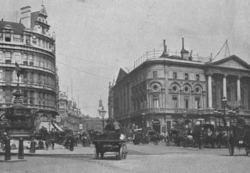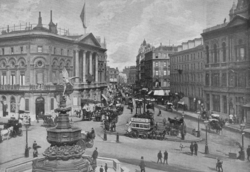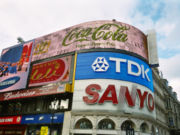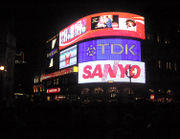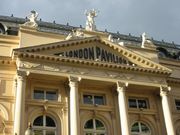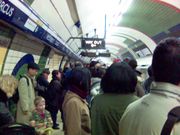Piccadilly Circus
2007 Schools Wikipedia Selection. Related subjects: Geography of Great Britain
Piccadilly Circus is a famous traffic intersection and public space of London's West End in the City of Westminster. Built in 1819 to connect Regent Street with the major shopping street of Piccadilly (the "circus" refers to "circular open space at a street junction"), it now links directly to the theatres on Shaftesbury Avenue as well as the Haymarket, Coventry Street (onwards to Leicester Square) and Glasshouse Street. The Circus is close to major shopping and entertainment areas in a central location at the heart of the West End. Its status as a major traffic intersection have made Piccadilly Circus a busy meeting point and a tourist attraction in its own right.
The Circus is particularly know for its video display and neon signs mounted on the corner building on the northern side, as well as the Shaftesbury memorial fountain and statue known as 'Eros' (sometimes called 'The Angel of Christian Charity', which would be better translated as 'Agape', but formally 'Anteros' - see below). It is surrounded by several noted buildings, including the London Pavilion and Criterion Theatre. Directly underneath the plaza is the London Underground station Piccadilly Circus.
History
Piccadilly Circus connects to Piccadilly, a thoroughfare whose name first appeared in 1626 as Pickadilly Hall, named after a house belonging to one Robert Baker, a tailor famous for selling piccadills or piccadillies, a term used for various kinds of collars. The street was known as Portugal Street in 1692 in honour of Catherine of Braganza, the queen consort of King Charles II of England, but was known as Piccadilly by 1743. Piccadilly Circus was created in 1819, at the junction with Regent Street, which was then being built under the planning of John Nash on the site of a house and garden belonging to a Lady Hutton. The circus lost its circular form in 1886 with the construction of Shaftesbury Avenue.
The junction has been a very busy traffic interchange since construction, as it lies at the centre of Theatreland and handles exit traffic from Piccadilly, which Charles C. B. Dickens, son of Charles Dickens, described as "the great thoroughfare leading from the Haymarket and Regent-street westward to Hyde Park-corner" and "the nearest approach to the Parisian boulevard of which London can boast."
The Piccadilly Circus tube station was opened 10 March 1906 on the Bakerloo Line, and on the Piccadilly Line in December of that year. In 1928, the station was extensively rebuilt to handle an increase in traffic.
The intersection's first electric advertisements appeared in 1910, and from 1923 electric billboards were set up on the facade of the London Pavilion. Traffic lights were first installed in August 3, 1926 at the junction.
At the start of the 1960s, it was determined that the Circus needed to be redeveloped to allow for greater traffic flow. In 1962, Lord Holford presented a plan which would have created a "double-decker" Piccadilly Circus, with a new pedestrian concourse above the ground-level traffic. This concept was kept alive throughout the rest of 60s, before eventually being killed by Sir Keith Joseph and Ernest Marples in 1972; the key reason given was that Holford's scheme only allowed for a 20% increase in traffic, and the Government required 50%.
The Holford plan is referenced in the short-form documentary film "Goodbye, Piccadilly", produced by the Rank Organisation in 1967. Piccadilly Circus has since escaped major redevelopment, apart from extensive ground-level pedestrianisation around its south side in the 1980s.
The Shaftesbury Memorial Fountain in Piccadilly Circus was erected in 1893, to commemorate the philanthropic works of Anthony Ashley Cooper, 7th Earl of Shaftesbury. During the Second World War, the statue atop the Shaftesbury memorial fountain, The Angel of Christian Charity, was removed, and was replaced by advertising hoardings. It was returned in 1948. When the circus underwent reconstruction work in the late 1980s, the entire fountain was moved from the centre of the junction at the beginning of Shaftesbury Avenue to its present position at the southwestern corner.
Location and sights
Piccadilly Circus is surrounded by several major tourist attractions, including the Shaftesbury Memorial, Criterion Theatre, London Pavilion and several major retail stores.
Neon signs and the Coca-Cola display
Piccadilly Circus used to be surrounded by illuminated advertising hoardings on buildings since the early 1900s, but only one building now carries them, namely the one in the northwestern corner, between Shaftesbury Avenue and Glasshouse Street. The site is unnamed (usually referred to as Monico after the Café Monico which used to be on the site); its addresses are 44/48 Regent Street, 1/6 Sherwood Street, 17/22 Denman Street and 1/17 Shaftesbury Avenue, and has been owned by property investor Land Securities Group since the 1970s.
The earliest signs used incandescent light bulbs, these were replaced with neon lamps, as well as moving signs (there was a large Guinness clock at one time). Briefly digital projectors were used for the Coke sign, while the early 2000s have seen a gradual move to LED displays. The number of signs has reduced over the years as the rental costs have increased.
As of 2005, the site has five illuminated advertising screens above three large retail units, facing Piccadilly Circus on the north side, occupied by Boots, Burger King and GAP and a mix of smaller retail, restaurant and office premises fronting the other streets. In September 2003, Coca Cola replaced its old illuminated board and the site formally occupied by Nescafé with a state-of-the-art LED video display that curves round with the building. Below the Coca Cola sign, are Sanyo and TDK, together with the squarish McDonald's LED. On the left is the Samsung board, being upgraded from neon to LED in 2005.
Vodafone also has a sign installed on the roof of Coventry House facing Piccadilly Circus. In addition to the logo of the company, the sign displays personal messages that can be entered on a Vodafone website and displayed at a certain time and date.
Shaftesbury Memorial and Eros
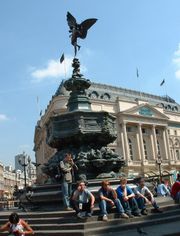
At the south-western side of the Circus, moved from its original position in the centre, stands the Shaftesbury Monument memorial fountain, erected in 1892-1893 to commemorate the philanthropic works of Lord Shaftesbury. It is topped by Alfred Gilbert's winged nude statue, sometimes known as The Angel of Christian Charity. It is popularly known as Eros after the mythical Greek God of Love, although he is intended to be Eros' twin Anteros. The statue has become a London icon, and a graphical illustration of the statue is used as the symbol of the Evening Standard newspaper and appears on its masthead.
The use of a nude figure on a public monument was controversial at the time of its construction, but it was generally well-received by the public. The Magazine of Art described it as, "...a striking contrast to the dull ugliness of the generality of our street sculpture, ... a work which, while beautifying one of our hitherto desolate open spaces, should do much towards the elevation of public taste in the direction of decorative sculpture, and serve freedom for the metropolis from any further additions of the old order of monumental monstrosities."'
Technologically ground-breaking at the time, this statue was the first in the world to be cast in aluminium. The statue originally pointed its bow to the north, up Shaftesbury Avenue. However, during the Second World War the statue was removed for safe keeping, and when it was returned its bow was fixed pointing in to the south, towards Lower Regent Street.
The winged figure on the fountain is generally called Eros, is often supposed to be The Angel of Christian Charity, but was intended to be Anteros, a brother of Eros, and is recorded as such in the records of Westminster City Council. The sculptor Alfred Gilbert had already sculpted a statue of Anteros, when commissioned for the Shaftesbury Memorial Fountain, and chose to reproduce the same subject, who as 'The God of Selfless Love' was deemed to suitably represent the philanthropic 7th Earl of Shaftesbury. Gilbert described Anteros as portraying 'reflective and mature love, as opposed to Eros or Cupid, the frivolous tyrant.' The model for the sculpture was a 16-year-old Italian, whose name appears to have vanished from history. The fountain, when originally placed, was meant to have Anteros pointing his bow towards Wimborne Saint Giles in Dorset, which was the Earl's country seat.
When the memorial was unveiled, there were numerous complaints. Some felt it was sited in a vulgar part of town (the theatre district) and others felt that it was too sensual as a memorial for a famously sober and respectable Earl. Some of the objections were tempered by renaming the statue as The Angel of Christian Charity, which was the nearest approximation that could be invented in the Christian pantheon for the role of Anteros in the Greek. But the name never became widely known, and the original name came back, under the shortened form Eros, signifying the God of Sensual Love; quite inappropriate to commemorate the Earl, but just right to signify the carnal neighbourhood of London, into which Soho had developed.
The iconography deteriorated to the level where the memorial came to be seen as the lustful, half-naked Eros burying his shaft up Shaftesbury Avenue, absolutely typifying degenerate Soho. During his life-time Gilbert had already said of his sculpture 'There is more than £3,000 worth of copper. take it down, melt it, and turn it into pence and give it to the unfortunate people who nightly find a resting place on the Thames Embankment, to the everlasting shame and disgrace of the greatest metropolis in the world'.
Criterion Theatre
The Criterion Theatre, a grade II* listed building, stands on the south side of Piccadilly Circus. Apart from the box office area, the entire theatre, with nearly 600 seats, is underground and is reached by descending a tiled stairway. Columns are used to support both the dress circle and the upper circle, restricting the views of many of the seats inside.
The theatre was designed by Thomas Verity and opened as a theatre on March 21, 1874, although original plans were for it to become a concert hall. In 1883 it was forced to close to improve ventilation and to replace gaslights with electric lights, and was reopened the following year. The theatre closed in 1989 and was extensively refurbished, reopening in October 1992.
London Pavilion
On the north-eastern side of the Piccadilly Circus, on the corner between Shaftesbury Avenue and Coventry Street, is the London Pavilion. The first building bearing the name was built in 1859, and was a music hall. In 1885, Shaftesbury Avenue was built through the site of the Pavilion. A new London Pavilion was constructed, which also served as a music hall. In 1923, electric billboards were erected on the side of the building.
In 1934, the building underwent significant structural alteration, and was converted into a cinema. In 1986, the building was rebuilt, preserving the 1885 facade, and converted into a shopping arcade. In 2000, the building was connected to the neighbouring Trocadero Centre, and signage on the building was altered in 2003 to read "London Trocadero." The basement of the building connects with Piccadilly Circus tube station.
Major shops
The former Tower Records flagship store, now acquired by Virgin Megastore, can be found at Number 1 Piccadilly, on the west side between Regent Street and Piccadilly, directly facing Piccadilly Circus. There is a direct exit to the Underground station on the basement level. Rival store HMV also has a branch inside the London Trocadero.
Lillywhites is a major retailer of sporting goods located on the south side, next to the Shaftesbury fountain. It moved to its present site in 1925.
Underground station and the Piccadilly Line
The Piccadilly Circus station on the London Underground is located directly beneath Piccadilly Circus itself, with entrances at every corner. It is one of the few stations which have no associated buildings above ground and is fully underground. It is itself a Grade 2 listed building.
The station is on the Piccadilly Line between Green Park and Leicester Square, and the Bakerloo Line between Charing Cross and Oxford Circus.
Metronet, one of the three private operators of the London Underground under a public-private partnership arrangement, is investing some £14 million to refurbish Piccadilly Circus station. Works are scheduled to begin in March 2005 and will be completed in spring 2007. Major improvements planned include new floor and wall finishes, a new CCTV system, new help points, a new public address system, new electronic information displays and clocks, improved platform seating, waterproofing measures, measures to assist visually impaired passengers and improved lighting. Escalators will also be replaced.
Piccadilly Circus in popular culture
The phrase "it's like Piccadilly Circus" is commonly used in the UK to refer to a place or situation which is extremely busy with people. It has been said that a person who stays long enough at Piccadilly Circus will eventually bump into everyone they know. In the United States, this would be the equivalent to "it's like Grand Central Station." Probably because of this connection, during World War II, "Piccadilly Circus" was the code name given the Allies' D-Day invasion fleet's assembly location in the English Channel.
Piccadilly Circus has inspired artists and musicians. Piccadilly Circus (1912) is the name and subject of a painting by British artist Charles Ginner, part of the Tate Britain collection. Photographer Paul McCarthy also has a 320-page two-volume edition of photographs by the name of Piccadilly Circus.
Piccadilly Circus is the name of Swedish singer Pernilla Wahlgren's hit song from 1985. Northern Irish punk band Stiff Little Fingers had a different song of the same name from their 1981 album Go For It, a true story about a friend of theirs migrating to London to escape The Troubles of Belfast only to get stabbed by strangers in Piccadilly Circus. A compilation album from the British pop/rock band Squeeze released in 1996 was titled Piccadilly Collection and showed a picture of Piccadilly Circus on its cover.
The Dire Straits song "Wild West End" is about the area around Piccadilly. The Morrissey song Piccadilly Palare from the album "Bona Drag" recounts the life of male prostitutes by employing the use of "palare" (alternatively spelled ' polari'), argot used by this subculture and by gay men generally. A lost verse: "Around the centre of town/is where I belong/am I really doing wrong?" Jethro Tull mention Piccadilly Circus in Mother Goose on Aqualung album: "And a foreign student said to me/was it really true there are elephants and lions too/in Piccadilly Circus?"
Bob Marley makes mention of Piccadilly Circus in his song "Kinky Reggae" off of the album Catch A Fire. The Sundays mention Piccadilly Circus in their song "Hideous Towns" off their 1990 album Reading, Writing, and Arithmetic.
Stormbreaker, the first novel in the bestselling Alex Rider serie by Anthony Horowitz, featured many major landmarks in London, one of them Picadilly Circus. The main characters race down the circus on horseback.

